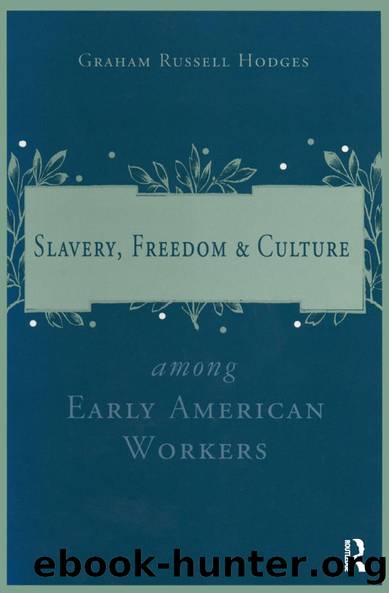Slavery and Freedom Among Early American Workers by Graham Russell Hodges

Author:Graham Russell Hodges [Hodges, Graham Russell]
Language: eng
Format: epub
ISBN: 9780765601124
Barnesnoble:
Publisher: Taylor & Francis
Published: 1998-01-31T00:00:00+00:00
* Douglas R. Egerton. Gabrielâs Rebellion: The Virginia Slave Conspiracies of 1800 and 1802. Chapel Hill: University of North Carolina Press, 1993.
7
Reconstructing Black Womenâs History in the Caribbean
These three trim books* offer excellent introductions to the vast, emerging history of black Caribbean women and stand as challenges to North American social historians to match their efforts. Despite the recent flood of literary and sociological studies on African-American women, social, feminist and ethnic historians have neglected this fruitful subject. Those wishing to learn more about black women in early America, for example, must rely on very few books and articles.1 The simultaneous arrival of three solid books on Caribbean women provides a major step forward for West Indian historiography and offers important lessons for North American scholars.
The three books are quite similar in intent and approach. Hilary Beckles, responding to the demands of female graduate students, attempts to expand existing conceptual and methodological approaches in order to provide a labor history of black women in Barbados. Barbara Bushâs concentration is primarily on Jamaica and other Anglophone colonies after the close of the slave trade in 1807. With skill and originality she emphasizes the power of sexual dynamics in the slave system and its resulting coloring of historical perceptions of black women. Marietta Morrissey ambitiously seeks to analyze the slave womanâs experience in British, Dutch, French, Spanish and Danish West Indies from a broad Marxist perspective to determine whether or not gender defined slave status. As she is making a large geographical survey, her findings speak to either Frank Tannenbaumsâs âterms of the religious and cultural variations of slavery or to the stages of capitalist development suggested by his criticsâ p. 15). Second, gender study addresses for Morrissey the issue of the economic basis of Caribbean slavery. As might be surmised, Morrissey uses a materialist strategy, acknowledging slavesâ economic motives rather than an unequal structuralist explanation or study of slave culture. The latter she regards as unwarranted, exaggerated claims based on emotion and political intention. This final point sharply separates Morrissey from Beckles and Bush. Yet, because they agree that gender is the most prominent variable, the three authors assert that the slave womanâs history is sufficiently divergent from the maleâs to require reassessment of Caribbean history.
On the surface, the three works are quite similar in approach. The authors weave chapters on domestic slavery, field work and garden plots, discussions of fertility and child-bearing, and family structure towards goals of explaining the prevalence of womenâs resistance to slavery in the Caribbean. Although each offers some new evidence, their principal approaches are to reinterpret existing research in order to provide new frameworks for analysis rather than to introduce major new areas of evidence. These goals provide a firm platform on which future efforts can stand. As the organization, evidence and, often, conclusions of the three books are frequently close, this review concentrates on areas of agreement and contention in key methods and points of analysis.
The first important subject is the demography of Caribbean slave women.
Download
This site does not store any files on its server. We only index and link to content provided by other sites. Please contact the content providers to delete copyright contents if any and email us, we'll remove relevant links or contents immediately.
The Apogee - Byzantium 02 by John Julius Norwich(1411)
The Mysteries of Mithra by Cumont Franz(1330)
A Short History of England by Simon Jenkins(1288)
The Tragedy of the Templars by Michael Haag(1206)
The Case for God by Karen Armstrong(1203)
Sacred Britannia: The Gods and Rituals of Roman Britain by Aldhouse-Green Miranda(1132)
All the Pope's Men by John L. Allen Jr(1044)
Raising Hell: A Concise History of the Black Arts and Those Who Dared to Practice Them by Robert Masello(951)
The Physics Book by DK(929)
War by Unknown(904)
Christian by Sean Michael(900)
The Evolution of God by Robert Wright(855)
Life Stories by unknow(840)
Living With the Gods: On Beliefs and Peoples by Neil MacGregor(808)
Early Daoist Dietary Practices by Shawn Arthur(805)
Great Transformation by Karen Armstrong(791)
A Cup of Trembling by Dave Hunt(788)
Football School Season 2 by Alex Bellos(788)
Making Haste From Babylon(783)
